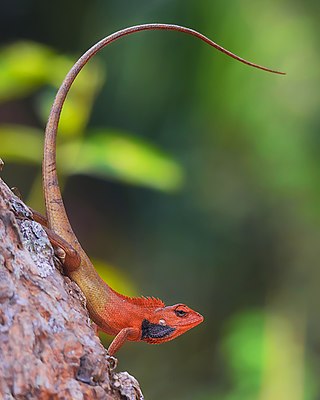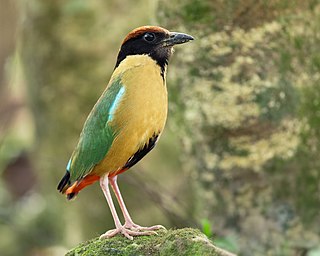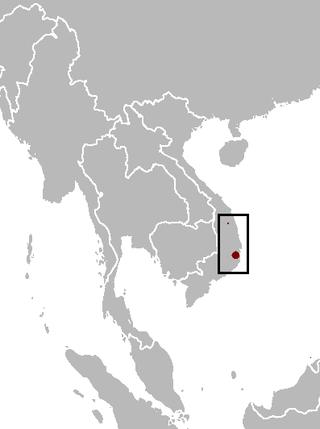
The green pheasant, also known as the Japanese green pheasant, is an omnivorous bird native to the Japanese archipelago, to which it is endemic. Some taxonomic authorities consider it a subspecies of the common pheasant, Phasianus colchicus. It is the national bird of Japan.

Tinea versicolor is a condition characterized by a skin eruption on the trunk and proximal extremities. The majority of tinea versicolor is caused by the fungus Malassezia globosa, although Malassezia furfur is responsible for a small number of cases. These yeasts are normally found on the human skin and become troublesome only under certain conditions, such as a warm and humid environment, although the exact conditions that cause initiation of the disease process are poorly understood.

The silver teal or versicolor teal is a species of dabbling duck in the genus Spatula. It breeds in South America.

The Antilles pinktoe tarantula, also known as the Martinique red tree spider or the Martinique pinktoe, is popular as a pet spider because of its docile character and unique coloration.

The oriental garden lizard, also called the eastern garden lizard, Indian garden lizard, common garden lizard, bloodsucker or changeable lizard, is an agamid lizard found widely distributed in Indo-Malaya. It has also been introduced in many other parts of the world.

Iris versicolor is also commonly known as the blue flag, harlequin blueflag, larger blue flag, northern blue flag, and poison flag, plus other variations of these names, and in Britain and Ireland as purple iris.

Trametes versicolor – also known as Coriolus versicolor and Polyporus versicolor – is a common polypore mushroom found throughout the world. Meaning 'of several colors', versicolor accurately describes this fungus that displays a unique blend of markings. Additionally, owing to its shape being similar to that of a wild turkey's tail feathers, T. versicolor is most commonly referred to as turkey tail. A similar-looking mushroom commonly called "false turkey tail" is from a different order (Stereum), and thus may sometimes be confused with the 'true' turkey tail mushroom, T. versicolor. Another lookalike is the multicolor gill polypore, T. betulina.

The gray treefrog is a species of small arboreal holarctic tree frog native to much of the eastern United States and southeastern Canada.

The Iris flower data set or Fisher's Iris data set is a multivariate data set used and made famous by the British statistician and biologist Ronald Fisher in his 1936 paper The use of multiple measurements in taxonomic problems as an example of linear discriminant analysis. It is sometimes called Anderson's Iris data set because Edgar Anderson collected the data to quantify the morphologic variation of Iris flowers of three related species. Two of the three species were collected in the Gaspé Peninsula "all from the same pasture, and picked on the same day and measured at the same time by the same person with the same apparatus".

Panulirus versicolor is a species of spiny lobster that lives in tropical reefs in the Indo-Pacific. Other names include painted lobster, common rock lobster, bamboo lobster, blue lobster, and blue spiny lobster. P. versicolor is one of the three most common varieties of spiny lobster in Sri Lanka, alongside Panulirus homarus and Panulirus ornatus.

The varied lorikeet, is a species of parrot in the family Psittacidae that is endemic to the northern coastal regions of Australia. It is the only species in the genus Psitteuteles.

The noisy pitta is a species of bird in the family Pittidae. The noisy pitta is found in eastern Australia and southern New Guinea. It eats earthworms, insects and snails. Its natural habitats are temperate forests, subtropical or tropical moist lowland forest, and subtropical or tropical moist montane forest.

Bendiocarb is an acutely toxic carbamate insecticide used in public health and agriculture and is effective against a wide range of nuisance and disease vector insects. Many bendiocarb products are or were sold under the tradenames "Ficam" and "Turcam."

The Vietnam mouse-deer, also known as the silver-backed chevrotain, is an even-toed ungulate in the family Tragulidae known only from Vietnam. It was first described in 1910 by British zoologist Oldfield Thomas, who procured four specimens from Nha Trang in Annam. Little is known about its distribution and ecology. After 1910, the Vietnam mouse-deer was reported next in 1990 near Dak Rong and Buon Luoi in the Gia Lai Province. With increasing hunting pressure, habitat loss due to deforestation and no more reports of the species in the wild, the mouse-deer was feared to have gone extinct. The IUCN listed the species as Data Deficient in 2008. In 2019, a study confirmed the presence of the Vietnam mouse-deer in dry low-lying forests of southern Vietnam with camera trap evidence. The mouse-deer is characterised by a rough coat with a strange double-tone coloration unseen in other chevrotains; the front part of the body is reddish brown and contrasts strongly with the greyish posterior. It has big reddish brown ears, white and dark reddish brown marks on the throat.

Polysaccharide-K is a protein-bound polysaccharide isolated from the mycelium of Trametes versicolor.
Decliniidae is a family of beetles belonging to Scirtoidea. It contains the single genus Declinia with two species, D. relicta and D. versicolor, found in the Russian Far East and Japan, respectively. Little is known of their ecology, and their larvae are unknown. Specimens of D. relicta were found with pollen grains in their gut.

Aspergillus versicolor is a slow-growing species of filamentous fungus commonly found in damp indoor environments and on food products. It has a characteristic musty odor associated with moldy homes and is a major producer of the hepatotoxic and carcinogenic mycotoxin sterigmatocystin. Like other Aspergillus species, A. versicolor is an eye, nose, and throat irritant.

Hemilophini is a tribe of longhorn beetles of the subfamily Lamiinae.
Apagomerella is a genus of longhorn beetles of the subfamily Lamiinae, containing the following species:
Apagomerella dissimilis is a species of beetle in the family Cerambycidae. It was described by Galileo and Martins in 2005. It is known from Costa Rica.
















